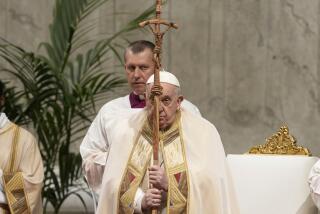Hidden Encyclical Could Have Changed World
- Share via
As the 20th century draws to a close, Pope John Paul II is expected to journey to the Holy Land as a pilgrim to help mark the millennium. He is also expected to make a decision regarding the candidacy for sainthood of three of his predecessors, John XXIII, Paul VI and Pius XII who was the pope during the Holocaust. The latter’s beatification would be condemned by many Jewish organizations and survivors of the Holocaust, including the Simon Wiesenthal Center.
Only last week, a London newspaper said that the independent judge for the cause of Pius XII’s beatification, Father Peter Gumpel, reported finding much evidence of his efforts to protect Jews.
Another predecessor, Pius XI, is not being considered for sainthood. Yet it is this pope more than any other who many believe came closest to dramatically changing the history of the 20th century.
Achille Ratti took the name Pius XI in 1922, when he was elected pope--the same year Benito Mussolini marched on Rome. Ratti previously headed two great libraries, the Ambrosian Library in Milan and, later, the Vatican Library in Rome.
But his misfortune was presiding over the church during the advent of the “age of the dictators”--Mussolini and Hitler. In the early years, Pius XI, despite his misgivings, sought accommodation with them fearing that confrontation would only weaken the church. So in 1929, he signed a Concordat with fascist Italy that protected the independence of the Vatican but lessened his ability to confront Mussolini’s aggression against Ethiopia or the dictator’s use of poison gas against civilian Abyssinians.
Similarly Pius XI allowed his secretary of state, Cardinal Eugenio Pacelli (the future Pius XII), to sign a Concordat with Hitler in 1933, hoping to preserve Catholic institutions in Germany.
But the moral cost was high. He did not protest when the Germans passed the first anti-Semitic laws in 1933 excluding non-Aryans from public office, nor did he protest when the Germans passed the infamous Nuremberg Laws in 1935.
The record is clear that Pius XI was greatly troubled by his deal with the devil, and the more he observed the Nazis’ inhumanity and deceit, the more determined he was to confront them. In his 1937 encyclical--a paper expressing and developing the doctrine of the church in a particular subject area--”Mit Brennender Sorge” (“With Burning Anxiety”), he lambasted those who worshiped the superiority of race. A year later, when the Austrian Cardinal Theodor Innitzer welcomed Hitler’s takeover of Austria, Pius XI summoned him to the Vatican and forced him to issue a humiliating public retraction.
But the apex of Pius XI’s resistance came when he ignored his own inner circle of advisors and instructed an American Jesuit priest visiting the Vatican, Father John Lafarge, to write an encyclical condemning racism and anti-Semitism. The pope had read Lafarge’s book on the racial injustice done to American blacks and knew instinctively that Lafarge was the right man for the job. He told the startled priest to write the encyclical as if he were the pope. Lafarge and two colleagues worked feverishly outside of Paris to prepare the document that they called, “Humani Generis Unitas” (“Unity of the Human Race”). On Sept. 20, 1938, Lafarge handed in the completed document to Wladimir Ledochowski, the Father Superior of the Jesuits in Rome. Although the document retained elements of Catholic teachings--that the Jews’ rejection of Christ caused them “to perpetually wander over the face of the Earth”--it also condemned anti-Semitism in language never before uttered by a pope and never acknowledged by the church for 20 centuries.
“Millions of persons are deprived of the most elementary rights, denied legal protection against violence and robbery, exposed to every insult and public degradation. Innocent persons are treated as criminals; even those who in time of war fought bravely for their country are treated as traitors. . . . This flagrant denial of human rights sends many thousands of helpless persons out over the face of the Earth without any resources.”
Coincidentally, on the day Lafarge handed in the encyclical, Pius XI, speaking to a group of Christian pilgrims, said, “Abraham is our patriarch and forefather. Anti-Semitism is incompatible with that lofty thought. It is a movement with which we Christians can have nothing to do. . . . No, no, I say to you . . . It is impossible for a Christian to take part in anti-Semitism. It is inadmissible. . . . Spiritually, we are all Semites.”
Tragically, Lafarge’s document was too shocking for some conservative prelates in Rome. They delayed sending it on to the ailing pope, who kept asking for it but never saw it until it was too late. With Lafarge’s encyclical on his desk, Pius XI died on Feb. 10, 1939, before he could sign it. The new pope, Pius XII, refused to issue it. Mysteriously, the document soon disappeared and not another word was heard about it until the National Catholic Reporter broke the story some 43 years later.
What would have happened if the encyclical had been signed? Many believe that it would so have divided Germany’s 45 million Catholics, that it would have delayed or prevented Hitler’s plans of launching World War II.
While the three candidates for sainthood can claim many achievements, only Pius XI was willing to confront Adolf Hitler, no matter what the consequences. It is sad that this significant achievement has been condemned to the anonymity of the hidden stacks in his much beloved Vatican library.
More to Read
Sign up for Essential California
The most important California stories and recommendations in your inbox every morning.
You may occasionally receive promotional content from the Los Angeles Times.










